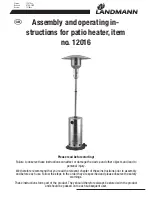
Version 5.1_2021 (31 March 2021)
9
5.
Description of the components
5.1.
Brief description of the cabinet layout.
Seen from the front to the back in the direction of airflow.
- Housing with 2 holes (500 mm)
o
External air intake connection
o
Water-side connection by means of Bauer coupling ball valve. (cold / hot water)
Optional water connection for the defrosting heater
- 2x air control dampers
- Suction filter G4
- Three-way cold water system
- Cooling coil incl. defrosting heater
o
plastic drip tray
o
droplet eliminator
o
siphons
- 2 fans
o
Directly driven with EC motors
o
Removable from the side
- 2x air control dampers
- Housing with 2x connections (500mm)
o
For attaching supply air hoses
- Control panel (behind plastic, transparent panel)
o
Accessible from outside
- Switch panel behind closed door (CE)
o
Can only be opened with special tools
The dampers of the Compact Cool 100 are manually operated and can be locked. Electrical connection (16
ampere) Menneke plug, 5-pin without 0. In the following subchapters, all components are listed separately
and the required maintenance is indicated.
5.2.
(Air control) dampers
The external air intake is equipped as standard with a volume control damper with manual operation and
locking device. The dampers in the air outlet are also manually operated with a locking device. The dampers
are standard contra-rotating dampers with aluminium housing, aluminium damper blades and plastic
maintenance-free actuator.
5.2.1.
Damper maintenance
The volume control dampers must be checked regularly for proper functioning and wear.
5.3.
Filter
The intake filter is a G4 filter consisting of pleated filter material with a metal frame. The filters are mounted
in a metal sliding profile.
5.3.1.
Filter maintenance
The filters must be replaced when the specified end resistance is reached. A non-urgent fault message on
the display of the Compact Cool indicates that the filters must be replaced. Replace the filters with new ones
of the same type, ensuring correct positioning and safe (working) conditions.
When changing the filters, you should also clean the filter section.
Check the existing pressure sensors for proper functioning.










































